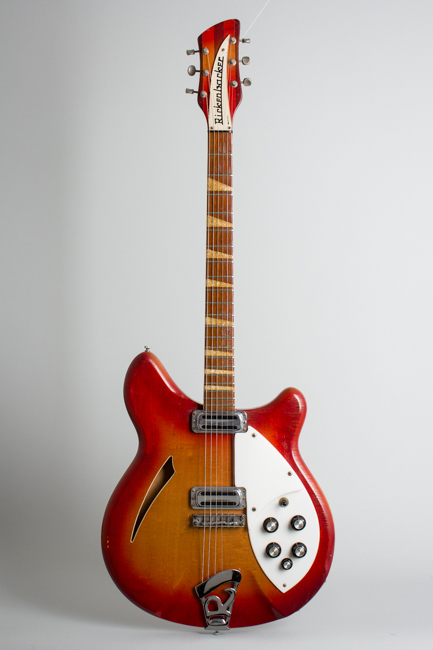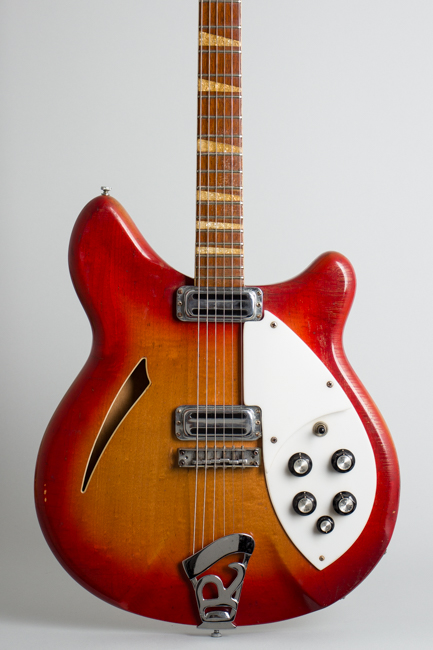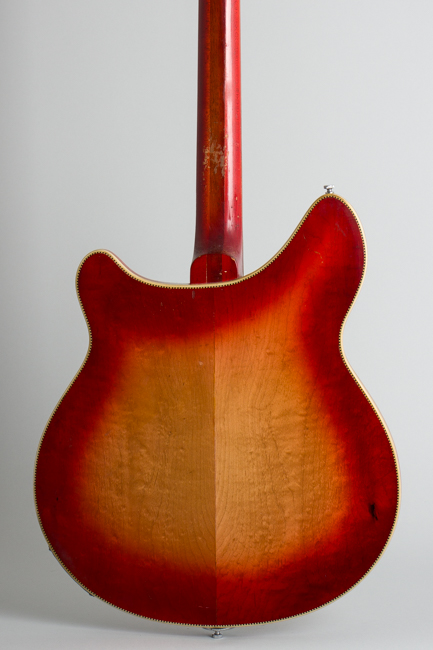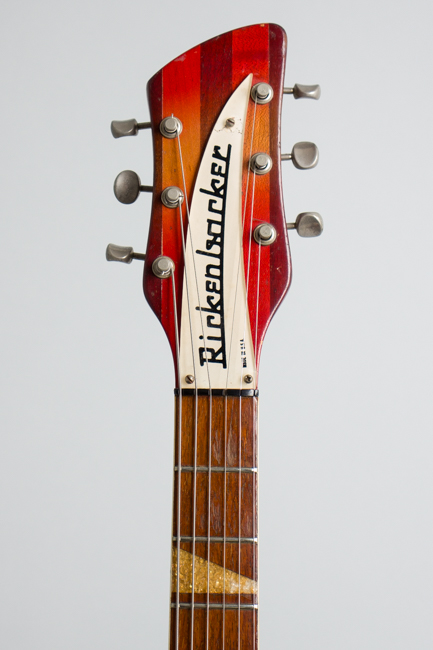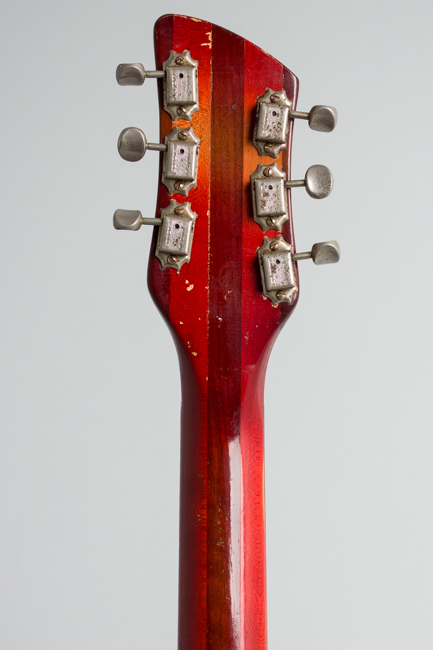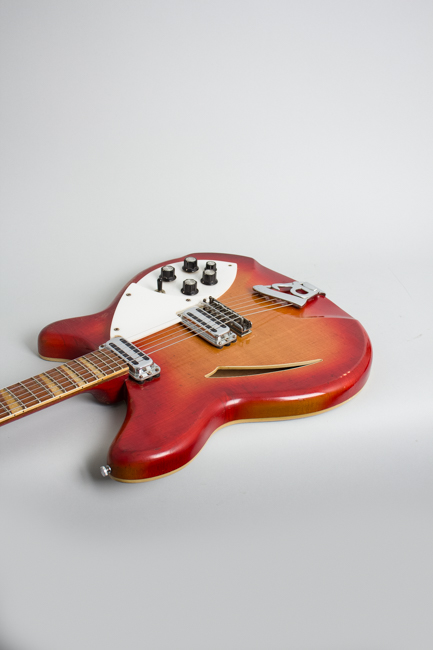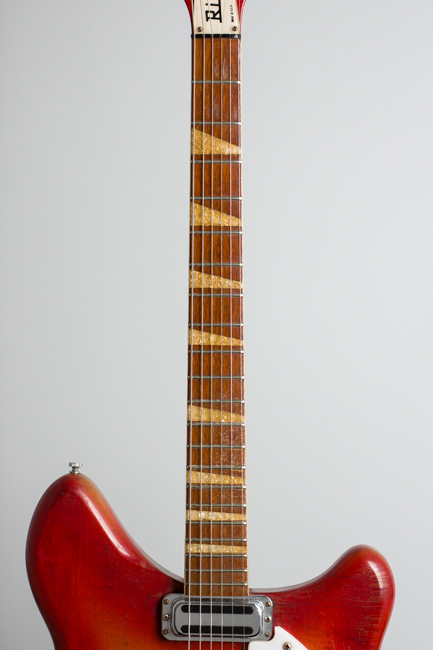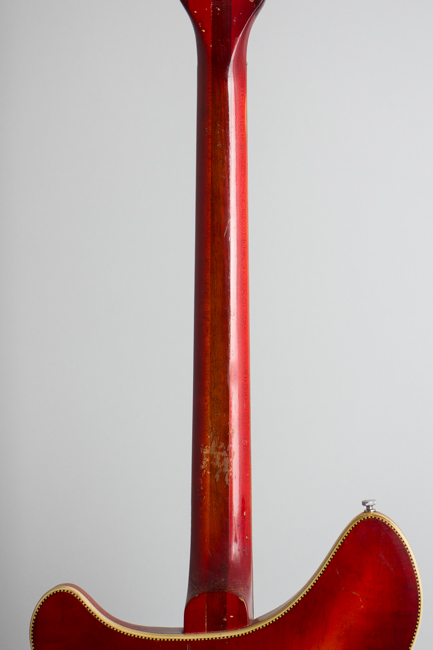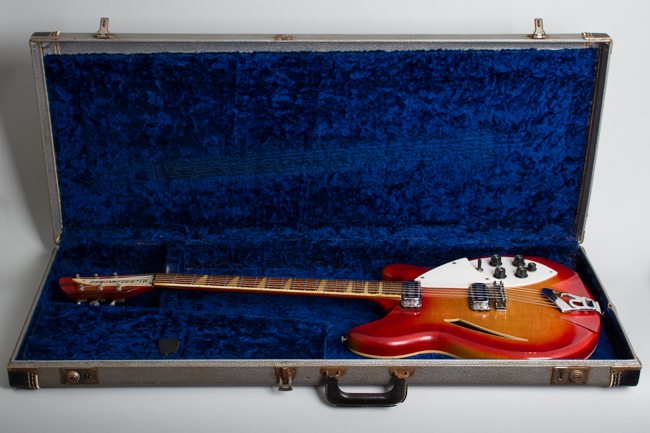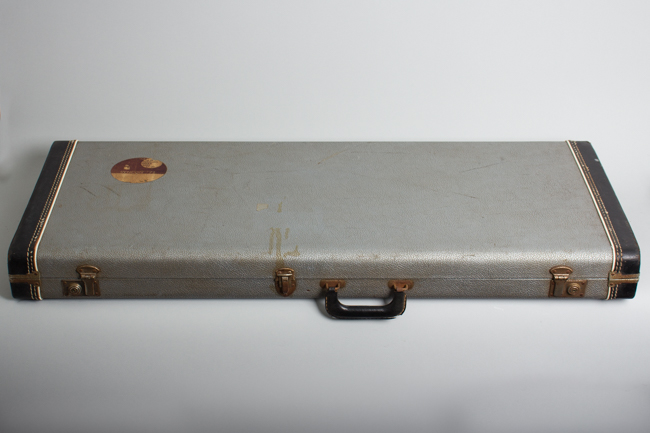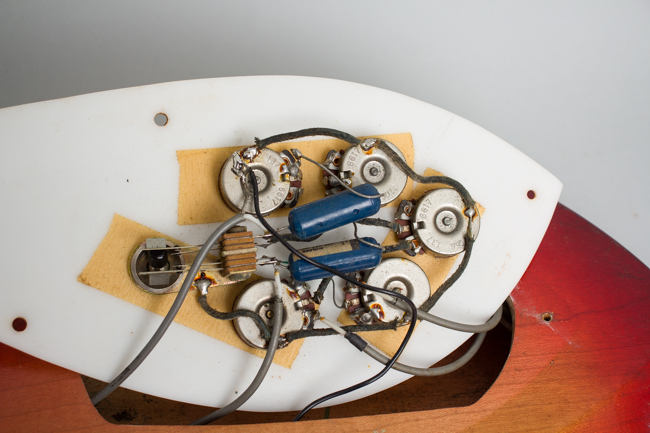Rickenbacker Model 360 Thinline Hollow Body Electric Guitar (1967)
Rickenbacker Model 360 Model Thinline Hollow Body Electric Guitar (1967), made in Santa Ana, CA, serial # GB-572, Fireglow red sunburst finish, maple body and neck, padouk fingerboard, original silver Tolex hard shell case.
One of the most instantly recognizable of all classic 1960s guitars, the Rickenbacker "300" series of thin hollow-body guitars has returned to favor again and again as new generations discover its bright, well-defined sound and utterly distinctive look and feel. This is a well worn but good player's example of a "Fireglo" (red sunburst finish) Model 360 from early 1967. This sleek California hot rod has been the mainstay of Rickenbacker's line from the late 1950s to the present, and one of the most popular guitars of this period. The round-edge (post-1964) Model 360 is virtually an icon of the 1960s, synonymous with the music and sounds of that era as well as more recent styles. They remain one of the sharpest-looking and most distinctive-sounding of all vintage designs.
The Model 360 designation refers to Rickenbacker's "Deluxe" features combined with two pickups and no vibrato; the 365 added that feature while the 370 and 375 have three pickups. This trademark "Fireglo" sunburst finish with a vibrant red-natural fade is the look most associated with these Rickenbacker models, a truly unique livery that still stands out in any crowd. The white trim sets this off perfectly.
This guitar was built in February 1967, just after the model's peak of popularity. The "Deluxe" features include a round-topped carved maple body with checkerboard binding on the back and a bound "cat's-eye' soundhole on the face. The laminated maple/walnut neck has a lacquered padauk fingerboard with "slash" inlay made of crushed pearloid. The headstock is fitted with Kluson Deluxe tuning keys and the trademark white Rickenbacker logo headplate.
The two "toaster top" pickups are mated to a 5-knob wiring rig allowing maximum blending flexibility, with pots dated the 17th week of 1966. The guitar is wired with the "Rick-O-Sound" stereo output the company has installed for decades but few players have ever used. A convenient mono jack is provided as well...a most useful feature Gibson missed!
Rickenbacker's instruments of this period are generally more consistent in than many others but one production change is significant. Beginning in summer 1966, a channel was no longer routed for pole magnets under the neck pickup, so from that point on they have a much solider neck/body joint. As a result this example made around 6 months later has maintained a better neck angle than many earlier 300-series models, making for excellent playability.
The single most famous 330 series Rickenbacker guitar would be John Lennon's 1964 Model 325, used during the Beatles peak of worldwide fame. Following the Beatles' lead, many young musicians both in the UK and US in the 1964-68 era chose thinline Rickenbacker guitars, making them an enduring 6-string symbol of the period. The models 335 and 345 are most firmly associated with the early Who; the group's first records are a showpiece for the unique Rickenbacker sound. Despite sometimes being dismissed with a "1960s cliche'" tag, the Rickenbacker 360 is a more versatile guitar than many realize, a great-sounding and very classy instrument for both retro and modern sounds!
Overall length is 40 in. (101.6 cm.), 15 1/4 in. (38.7 cm.) wide at lower bout, and 1 1/2 in. (3.8 cm.) in depth, measured at side of rim. Scale length is 24 3/4 in. (629 mm.). Width of nut is 1 9/16 in. (40 mm.).
This is a fairly well-worn but fully solid example of this 1960's classic, a good player, worn in but nicely original. The original Fireglo finish has darkened and "smoked" somewhat over the decades, with a lot of micro-checking and surface wear. That said there are no really large areas worn away, but a lot of small chips, dings and flakes and some occluded spots on the surface that suggest exposure to moisture. The back of the neck has noticeable chipping behind the 12th fret area.
There are no cracks or breaks but some re-sealed seams on the guitar, along the back canter, the top center under the tailpiece and several spots on the neck laminates. This again points to a history with likely some moisture exposure in it. All have since been solidly sealed up, the laminate seam on the bass side of the neck can be felt but is not open anywhere. The fingerboard/neck seam by the nut shows less of the typical separations than many vintage Ricks, just some very slight re-sealing right behind it.
All hardware and fittings appear original; the saddles on the original bridge have been lowered and re-contoured long ago for a more comfortable feel. The neck angle is quite good, the frets have some wear in the lower positions but playability is not affected. The pickups and electronics sound great with the classic Rick chime; the wiring appears original but for some reason the fifth "blend" knob has no affect when the lever switch is in the treble position; otherwise it works correctly.
This guitar is not the cleanest '60s Rickenbacker we have had but remains an excellent "gigger" which can be put through its paces with less trepidation than a pristine example. It does the "Rick thing" perfectly and still resides in the original silver Tolex HSC, emblazoned with a single sticker indicating it attended "New World Week SYNCON '72". Overall Very Good + Condition.
One of the most instantly recognizable of all classic 1960s guitars, the Rickenbacker "300" series of thin hollow-body guitars has returned to favor again and again as new generations discover its bright, well-defined sound and utterly distinctive look and feel. This is a well worn but good player's example of a "Fireglo" (red sunburst finish) Model 360 from early 1967. This sleek California hot rod has been the mainstay of Rickenbacker's line from the late 1950s to the present, and one of the most popular guitars of this period. The round-edge (post-1964) Model 360 is virtually an icon of the 1960s, synonymous with the music and sounds of that era as well as more recent styles. They remain one of the sharpest-looking and most distinctive-sounding of all vintage designs.
The Model 360 designation refers to Rickenbacker's "Deluxe" features combined with two pickups and no vibrato; the 365 added that feature while the 370 and 375 have three pickups. This trademark "Fireglo" sunburst finish with a vibrant red-natural fade is the look most associated with these Rickenbacker models, a truly unique livery that still stands out in any crowd. The white trim sets this off perfectly.
This guitar was built in February 1967, just after the model's peak of popularity. The "Deluxe" features include a round-topped carved maple body with checkerboard binding on the back and a bound "cat's-eye' soundhole on the face. The laminated maple/walnut neck has a lacquered padauk fingerboard with "slash" inlay made of crushed pearloid. The headstock is fitted with Kluson Deluxe tuning keys and the trademark white Rickenbacker logo headplate.
The two "toaster top" pickups are mated to a 5-knob wiring rig allowing maximum blending flexibility, with pots dated the 17th week of 1966. The guitar is wired with the "Rick-O-Sound" stereo output the company has installed for decades but few players have ever used. A convenient mono jack is provided as well...a most useful feature Gibson missed!
Rickenbacker's instruments of this period are generally more consistent in than many others but one production change is significant. Beginning in summer 1966, a channel was no longer routed for pole magnets under the neck pickup, so from that point on they have a much solider neck/body joint. As a result this example made around 6 months later has maintained a better neck angle than many earlier 300-series models, making for excellent playability.
The single most famous 330 series Rickenbacker guitar would be John Lennon's 1964 Model 325, used during the Beatles peak of worldwide fame. Following the Beatles' lead, many young musicians both in the UK and US in the 1964-68 era chose thinline Rickenbacker guitars, making them an enduring 6-string symbol of the period. The models 335 and 345 are most firmly associated with the early Who; the group's first records are a showpiece for the unique Rickenbacker sound. Despite sometimes being dismissed with a "1960s cliche'" tag, the Rickenbacker 360 is a more versatile guitar than many realize, a great-sounding and very classy instrument for both retro and modern sounds!
Overall length is 40 in. (101.6 cm.), 15 1/4 in. (38.7 cm.) wide at lower bout, and 1 1/2 in. (3.8 cm.) in depth, measured at side of rim. Scale length is 24 3/4 in. (629 mm.). Width of nut is 1 9/16 in. (40 mm.).
This is a fairly well-worn but fully solid example of this 1960's classic, a good player, worn in but nicely original. The original Fireglo finish has darkened and "smoked" somewhat over the decades, with a lot of micro-checking and surface wear. That said there are no really large areas worn away, but a lot of small chips, dings and flakes and some occluded spots on the surface that suggest exposure to moisture. The back of the neck has noticeable chipping behind the 12th fret area.
There are no cracks or breaks but some re-sealed seams on the guitar, along the back canter, the top center under the tailpiece and several spots on the neck laminates. This again points to a history with likely some moisture exposure in it. All have since been solidly sealed up, the laminate seam on the bass side of the neck can be felt but is not open anywhere. The fingerboard/neck seam by the nut shows less of the typical separations than many vintage Ricks, just some very slight re-sealing right behind it.
All hardware and fittings appear original; the saddles on the original bridge have been lowered and re-contoured long ago for a more comfortable feel. The neck angle is quite good, the frets have some wear in the lower positions but playability is not affected. The pickups and electronics sound great with the classic Rick chime; the wiring appears original but for some reason the fifth "blend" knob has no affect when the lever switch is in the treble position; otherwise it works correctly.
This guitar is not the cleanest '60s Rickenbacker we have had but remains an excellent "gigger" which can be put through its paces with less trepidation than a pristine example. It does the "Rick thing" perfectly and still resides in the original silver Tolex HSC, emblazoned with a single sticker indicating it attended "New World Week SYNCON '72". Overall Very Good + Condition.
